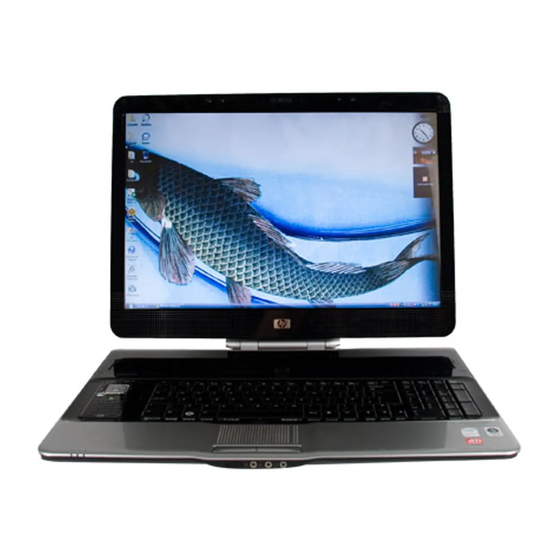
HP Pavilion HDX9000 User Manual
Drives
Hide thumbs
Also See for Pavilion HDX9000:
- Maintenance and service manual (163 pages) ,
- User manual (33 pages) ,
- Software update (12 pages)
Table of Contents
Advertisement
Advertisement
Table of Contents

Summary of Contents for HP Pavilion HDX9000
- Page 1 Drives User Guide...
- Page 2 Windows is a U.S. registered trademark of Microsoft Corporation. The information contained herein is subject to change without notice. The only warranties for HP products and services are set forth in the express warranty statements accompanying such products and services. Nothing herein should be construed as constituting an additional warranty.
-
Page 3: Product Notice
Product notice This user guide describes features that are common to most models. Some features may not be available on your computer. - Page 4 Product notice...
-
Page 5: Table Of Contents
Table of contents 1 Identifying installed drives 2 Handling drives 3 Using an optical drive Inserting an optical disc ... 4 Removing an optical disc when running on battery or external power ... 5 Removing an optical disc when no computer power is available ... 6 4 Improving hard drive performance Using Disk Defragmenter ... -
Page 7: Identifying Installed Drives
Identifying installed drives To view the drives installed on the computer, select Start > Computer. On models with a secondary hard drive (drive D), the optical drive becomes drive E. The next drive added to the system, such as a new USB drive, will be assigned the next available drive letter. If your computer has a secondary hard drive, the primary (first) hard drive (drive C) contains the operating system, applications, drivers, and Documents folder. -
Page 8: Handling Drives
Handling drives Drives are fragile computer components that must be handled with care. Refer to the following cautions before handling drives. Additional cautions are included with the procedures to which they apply. CAUTION: To reduce the risk of damage to the computer, damage to a drive, or loss of information, observe these precautions: Before handling a drive, discharge static electricity by touching the unpainted metal surface of the drive. -
Page 9: Using An Optical Drive
Using an optical drive An optical drive, such as a DVD-ROM drive, supports optical discs (CDs and DVDs). These discs store or transport information and play music and movies. DVDs have a higher storage capacity than CDs. Optical drives can read from and select models can write to optical media as described in the following table. -
Page 10: Inserting An Optical Disc
Inserting an optical disc Turn on the computer. Press the release button (1) on the drive bezel to release the media tray. Pull out the tray (2). Hold the disc by the edges to avoid touching the flat surfaces and position the disc label-side up over the tray spindle. -
Page 11: Removing An Optical Disc When Running On Battery Or External Power
Removing an optical disc when running on battery or external power Press the release button (1) on the drive bezel to release the media tray, and then gently pull out the tray (2) until it stops. Remove the disc (3) from the tray by gently pressing down on the spindle while lifting the outer edges of the disc. -
Page 12: Removing An Optical Disc When No Computer Power Is Available
Removing an optical disc when no computer power is available Insert the end of a paper clip (1) into the release access in the front bezel of the drive. Press in gently on the paper clip until the tray is released, and then pull out the tray (2) until it stops. Remove the disc (3) from the tray by gently pressing down on the spindle while lifting the outer edges of the disc. -
Page 13: Improving Hard Drive Performance
Improving hard drive performance Using Disk Defragmenter As you use the computer, files on the hard drive become fragmented. Disk Defragmenter consolidates the fragmented files and folders on the hard drive so that the system can run more efficiently. To run Disk Defragmenter: Select Start >... -
Page 14: Replacing The Hard Drive
Replacing the hard drive CAUTION: To prevent information loss or an unresponsive system: Shut down the computer before removing the hard drive from the hard drive bay. Do not remove the hard drive while the computer is on, in the Sleep state, or in Hibernation. If you are not sure whether the computer is off or in Hibernation, turn the computer on by pressing the power button. - Page 15 Loosen the hard drive screw (1). Slide the hard drive (2) to unlock it, and then lift the hard drive away from the computer (3). To install a hard drive: Insert the hard drive into the hard drive bay (1). Slide the hard drive until it locks into place (2).
- Page 16 Tighten the 6 hard drive cover screws (3). Chapter 5 Replacing the hard drive...
-
Page 17: Index
Index airport security devices 2 inserting 4 removing, with power 5 removing, without power 6 CD drive 3 Disk Cleanup software 7 Disk Defragmenter software 7 disk performance 7 drives caring for 2 hard 8, 9 optical 3 inserting 4 removing, with power 5 removing, without power 6 DVD drive 3...










Need help?
Do you have a question about the Pavilion HDX9000 and is the answer not in the manual?
Questions and answers